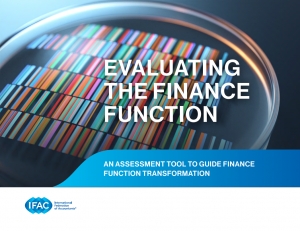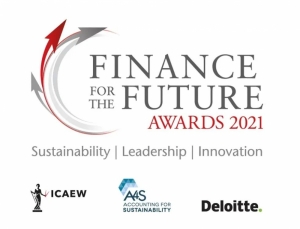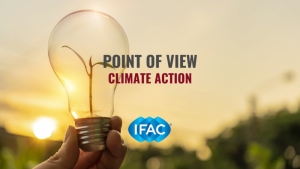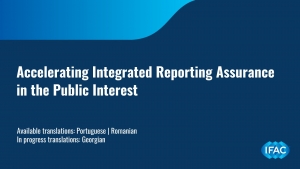عرض العناصر حسب علامة : IFAC
5 عوامل رئيسية لتعزيز فعالية لجنة التدقيق
إخفاقات الشركات وفضائحها عبر البلدان، بما في ذلك الانهيارات الأخيرة لشركة Carillion و Patisserie Valerie و London Capital & Finance في المملكة المتحدة، والاخفاقات في الكيانات المملوكة للدولة في جنوب إفريقيا Transnet و Eskom و South African Airways، وTransnet و Eskom و South African Airways، وفضيحة 1MDB في ماليزيا على سبيل المثال لا الحصر، ركزت جميعها علي الاهتمام السياسي والتنظيمي على مهنة التدقيق وكشفت أيضًا عن إخفاقات خطيرة في حوكمة الشركات.
معلومات إضافية
-
المحتوى بالإنجليزية
5 Key Factors to Enhance Audit Committee Effectiveness
Laurie Tugman, Laura Leka | September 20, 2019 | 2
Corporate failures and scandals across countries, including the recent collapses of Carillion, Patisserie Valerie and London Capital & Finance in the UK, failings in South Africa’s state-owned entities Transnet, Eskom, and South African Airways, and the 1MDB scandal in Malaysia to name a few, have all focused political and regulatory attention on the audit profession and also exposed serious corporate governance failings.
The result is increased debate globally on audit and governance regulatory reform.
Companies do not fail because of poor quality audits. An audit is designed to enhance confidence in financial reporting, but it does not relieve management or those charged with governance of their responsibilities. Ultimately, corporate failures and the resulting impacts on financial statements are consequences of poor governance and decisions.
Effective governance is underpinned by purpose, vision, values and ethics, that are reflected in the behaviors and actions of the board and management team and cascaded throughout the organization. The board in conjunction with management is responsible for setting the tone at the top, shaping the culture of the organization, and setting strategic direction. Organizations need to be proactive in driving improvements in their governance beyond adherence only to minimum requirements.
The board has ultimate responsibility for the integrity and accuracy of the company’s financial reporting, which includes ensuring implementation of internal controls over financial reporting, adoption of appropriate accounting policies, and appointment and oversight of independent external auditors. These responsibilities are often delegated by the board to its audit committee. But this delegation does not absolve the board of its obligations and accountability to shareholders and other stakeholders.
IFAC strongly supports efforts to strengthen and clarify the roles of boards and audit committees in exercising oversight of the statutory audit and financial reporting processes led by management, including addressing perceptions that audit committees are not sufficiently independent of management, or that there is insufficient communication from the audit committee to shareholders.
Effective audit committees are a critical part of delivering trust and confidence in reporting and risk management. However, globally audit committee responsibilities are widening beyond their core financial reporting oversight responsibilities, putting them under increasing pressure both in terms of time and expertise to oversee the major risks on their agendas in addition to fulfilling their core mandates.
Often if the board is not directly dealing with a matter or there isn’t another appropriate committee, by default whatever is left over falls to the audit committee to oversee: for example, cyber security and other technology related matters, as well as risk management beyond financial risk.
Audit committee responsibilities vary widely across jurisdictions, sectors and between companies. It is important to recognize that there is no one-size-fits-all model for audit committees and therefore enhancing their effectiveness will be more dependent on adoption of good practices rather than further prescriptive legislation or additional regulatory scrutiny.
With the input of IFAC’s Professional Accountants in Business (PAIB) Committee we have been exploring ways to enhance audit committee effectiveness and have identified five key factors:
1. Audit committee transparency
Increased transparency on how an audit committee has discharged its duties is crucial and enables a more informed assessment of its performance and effectiveness.
Many corporate governance codes and regulations include requirements around audit committee disclosure. In addition, voluntary disclosures continue to grow, reflecting that audit committees are responding to evolving expectations of investors and other stakeholders.
But while audit committee reporting may be increasing, the usefulness of disclosures varies.
In the US the CAQ 2018 Audit Committee Transparency Barometer, a review of audit committee disclosures by S&P 500 companies, revealed increased disclosure around audit firm appointment, length of audit firm engagement, change in audit fees, and criteria used to evaluate the audit firm. However, decreased disclosure was found around key questions such as:
Is there a discussion of audit fees and their connection to audit quality? 5% of companies included this, representing a continued downward trend since 2014 when 13% included this discussion
Is there a disclosure of significant areas addressed with the auditor? 0% included this vs 3% in 2014.
For audit committee reporting to be meaningful, there needs to be strong and candid disclosure of the audit committee’s work and key areas of its agenda and discussions. Such disclosure should provide insights on the significant issues the audit committee considered in relation to the financial statements, and how these issues were addressed.
If enhanced reporting by auditors through disclosure of key audit matters is mirrored by the audit committee in their own reporting, this could drive improved audit committee disclosure. It would be unusual for the audit committee not to give their perspective on an issue that the auditor considers a key audit matter. Analysis of audit committee reporting in the UK, shows how disclosure on material financial reporting risk is strongly aligned to auditor reporting on key audit matters.
2. Effective communication
The importance of effective communication flows to and from the audit committee cannot be overstated. This includes written and in person, formal and informal, communication with management, internal and external audit, the CFO and finance function, and the board.
For support in its oversight role, the audit committee relies on:
Meaningful insight from management on emerging risks on the horizon and focused updates on what is happening in the business, moving beyond the basics of what they do to focus on specific challenges, risks and opportunities
Concise and understandable meeting materials from management, the CFO and finance function, as well as internal and external audit. The volume of materials an audit committee must review can become unmanageable. Written information presented to the audit committee needs to communicate only the most important and relevant information for their attention
Unrestricted access to the auditors without management present, as well as ongoing dialogue with the auditors outside of the audit window, to deal with issues on an ongoing basis and not just at the time of the audit
Informal communication with management and the CFO between audit committee meetings
Direct access to teams and departments, including those outside of finance, when appropriate (and ensuring the audit committee does not overstep its governance role).
The audit committee also needs to communicate with the board how it has discharged its responsibilities. It is not enough for the board to simply ‘rubber stamp’ reports from the audit committee; there needs to be full discussion and deliberation on key aspects of the audit committee’s work and any significant issues they have identified that warrant the full board’s attention.
3. Committee composition – including appropriate skills, competencies and expertise
Ensuring the right composition of the audit committee is vital but can be challenging. Requirements vary across jurisdictions, but generally there must be at least one member who is financially literate. This can put a huge burden on one individual if they are the only person on the audit committee to have financial reporting and accounting expertise.
Diversity of experience, perspectives and expertise, as well as industry knowledge are also extremely important, particularly given the widening mandates of audit committees beyond financial reporting oversight.
Audit committee members need continuing development and education to help them keep up-to-date on current issues. But often there is no formal education for audit committee members and even cases where audit committee members have never interacted with auditors prior to joining the audit committee.
Training programs, guidance and other support tools are essential to ensure the audit committee maintains knowledge of relevant developments in accounting and corporate reporting, as well as new technologies and their impact on the business and future of audit. Approaches to ensuring sustained expertise of the audit committee can be varied and include formal training and education, mentoring, and engagement with experts inside and outside the organization.
While the audit committee can rely on outside expertise, it is important that an effort is made to provide continuing professional education in order to understand emerging issues and develop an awareness of best practices.
4. How it gets its work done – efficient and effective ways of working
Audit committee mandates typically always widen, but nothing is generally removed. With increased workload along with increased complexity of risks on their agendas, audit committees need efficient and effective ways of working to ensure they can successfully discharge their oversight responsibilities.
Good practices include:
Having well-defined terms of reference setting out a clear scope of responsibilities, which are widely understood by the audit committee members, as well as by others in the organization including the board, CFO and finance function
Coordination between auditor, audit committee, and internal auditor to prevent duplicated effort, increased cost and poor effectiveness
Appropriate frequency and efficiency of meetings with focused agendas that allow sufficient time and attention for in-depth discussion on critical areas, as well as flexibility to add additional items as they arise
Producing short summaries to circulate to audit committee members in advance of meetings outlining key areas of focus for discussion
Holding a call or prep meeting between the audit committee chair and the auditor before each audit committee meeting.
5. Strength of the finance function
The finance function is responsible for producing reliable and auditable information for external disclosure. The strength of the finance function is therefore critical in supporting the oversight role of the audit committee, which can be severely inhibited by a weak finance function that lacks capacity, expertise or effective CFO leadership.
Considerations for the audit committee include whether the finance function is appropriately staffed and resourced, has suitably qualified people in key positions, as well as whether it has support for its continued development.
The audit committee also needs to consider whether they should have a role in appointment of key finance staff and finance function succession planning. The EY UK report Appointing CFOs for a rapidly changing world: the role of the Audit Committee suggests that “When it comes to appointing a new CFO, the audit committee chair should be an integral part of the interview process.” Indeed, “It’s a brave CEO who vetoes the audit committee chair’s recommendation.”
Much of the transactional work of the finance function including preparation of the financial statements is being enabled by technology, giving the finance function opportunities to improve its productivity, efficiency and effectiveness, and focus its attention on other value adding activities. To meet the future needs and demands of business, finance functions must transform themselves from technical support functions to business partners that enable and support decision making across their organizations.
To maximize the finance function’s value to the business, organizations need mechanisms in place to assess its effectiveness and support its development. Ultimately this responsibility lies with the board but may too be delegated to a committee of the board such as the audit committee.
In South Africa, which adopts a combined assurance model, the King IV Code on Corporate Governance recommends that the audit committee should provide independent oversight of the effectiveness of the organization’s combined assurance arrangements, including external assurance service providers, internal audit and the finance function. It also recommends that the audit committee discloses their views on the effectiveness of the CFO and finance function.
To support finance function transformation, IFAC has recently launched its “Future-Fit” series, which includes a high-level evaluation tool designed to support dialogue at the board (or audit committee) on the importance of finance function development, as well as help to identify priority areas for finance function investment.
قمة IFAC EdExchange: قيادة الاستدامة
معلومات إضافية
- البلد عالمي
- نوع الفعالية مجانا
- بداية الفعالية الثلاثاء, 12 أكتوبر 2021
- نهاية الفعالية الخميس, 14 أكتوبر 2021
- التخصص محاسبة ومراجعة
- مكان الفعالية أونلاين
الدور الأساسي للمدراء الماليين في تعزيز الصحة العقلية للموظفين
بالنسبة للمحاسبين المهنيين، تزيد مشكلات الصحة العقلية من مخاطر عدم تحديد الأخطاء في التقارير المالية أو اكتشاف مؤشرات الاحتيال.
معلومات إضافية
-
المحتوى بالإنجليزية
The following is a contributed piece from Russell Guthrie, CFO of the International Federation of Accountants (IFAC). Opinions expressed are author's own.
The coronavirus pandemic has put a long-overdue spotlight on mental health. Clinical studies have found a strong correlation between pandemic-related anxiety and behaviors, such as hopelessness or substance abuse, that companies cannot afford to ignore. Implementing an organizational framework to support mental health is not only the right thing to do, it's smart for business. With the potential to alleviate human and financial costs, support for mental health should be seen as core to the finance function’s role in promoting sustainable value creation.
In 2019, the World Health Organization estimated that mental health issues cost the global economy upward of $1 trillion per year. In the wake of the past year, that cost is likely to increase considerably, reinforcing the need for mental health to be a key priority for employers and organizations worldwide.
Addressing mental health successfully, however, will require the involvement of the entire C-suite — not just HR, and not just the CEO. The finance function must be a pivotal part of the conversation both in supporting the adoption of company initiatives and in examining the cultural values of the accountancy and finance profession globally.
Long-term growth and value creation
Creating a culture of understanding must be a critical priority for CFOs. Failing to care for employees can mean falling behind as an organization, particularly in sectors where a company’s best asset is its human capital. A 2020 Gallup survey found that two-thirds of full-time workers polled were facing burnout at least some of the time, and those people were three times more likely to look for another job. It’s both more humane and more cost-effective to support your talent’s well-being rather than risk a mass exodus and face the high price of attrition — especially if you have developed a reputation for burning out your employees.
Russell Guthrie
Courtesy of IFAC
Effectively addressing mental health by establishing the appropriate infrastructure to support employees can also play a determinant role in attracting and acquiring new talent. According to a recent report by the International Federation of Accountants (IFAC) and the Association of Chartered Certified Accountants (ACCA), Generation Z — the group of 18-25-year-olds entering the workforce during the pandemic — cites mental wellbeing as a top priority when seeking employment.
CFOs must be advocates for the crucial relationship between employee mental health and a company’s bottom line. Fatigue, burnout and other signals of strained mental health stand in opposition to the creativity, collaboration and stamina required to stoke growth and resiliency within companies.
A unique threat
The finance function — and, more specifically, accountancy profession — is innately people-centered, relying on equal parts technical and non-technical capabilities. Professional accountants, in particular, are responsible for critically reviewing information and large sets of data to ensure accuracy and compliance with laws and regulations, as well as evaluating conflicts of interest — a job that demands mental acuity, attention to detail and good judgement. Unsurprisingly, when people are under mental strain, it is increasingly difficult to focus on the task at hand.
For a professional accountant this may heighten the risk of not identifying errors in financial reports or impact one’s ability to spot indicators of fraud, both of which can have far-reaching consequences. It’s not enough, however, to recognize what is at stake. Leaders have to promote a culture that will mitigate those risks.
By nature, the accountancy profession is built on the expectation of perfection. Working against a standard of excellence — with little room for error — professional accountants face numerous internal and external pressures. And particularly now, as the global economy recovers from the impacts of COVID-19, professional accountants are facing increasing stress as the institutions they support focus on rebuilding.
Such high expectations create an environment ripe for the deterioration of mental health. This, coupled with the general stigma surrounding mental health, often results in hesitation to recognize or address fatigue, depression, or any other mental health issues.
Mental health must be included among the tenets of ethical and good business performance. A robust financial system is the bedrock of any thriving economy, and the people who uphold the rigor of high-quality accounting have to be a top priority.
Building the infrastructure
Mental health must be considered part of an organization’s environmental, sustainability and governance (ESG) strategy and approached as would the provision of any other basic human right. Just as global standards are a critical vehicle for reaching sustainability goals, a similarly rigorous approach will help companies, both large and small, establish the necessary infrastructure to properly support employee well-being.
The right response will likely look different from region to region and from organization to organization, but the essential first step is simply making mental health part of the ongoing dialogue of the organization. From there, organizations must deploy initiatives for supporting employees and their ability to perform.
This will likely mean rethinking normalized processes to identify existing threats to well-being and potential barriers to care. For instance, some companies will need to reconsider the relentless focus managers place on productivity. Others will have to reevaluate insurance plans to consider coverage of mental health treatments. They should look to institute mental health literacy programs and leverage outside expert resources to empower employees to prioritize mental health and support those in their communities looking to do the same. Ultimately, leadership needs to be highly engaged in this effort. Successfully shifting corporate culture to prioritize mental well-being starts at the top.
While it’s not solely up to CFOs and the finance function to champion new and expanded norms for operating within the current reality, they are essential to creating a positive space to discuss and address employees’ mental health. It’s mission critical if we want to ensure businesses continue to operate as productively, sustainably, and ethically as possible.
دليل إدارة الممارسة للممارسات الصغيرة والمتوسطة الحجم
مرحبًا بكم في الإصدار الرابع من دليل الاتحاد الدولي للمحاسبين لممارسة الإدارة للممارسات الصغيرة والمتوسطة الحجم.
معلومات إضافية
-
المحتوى بالإنجليزية
Welcome to the fourth edition of the IFAC Guide to Practice Management for Small- and Medium-Sized Practices.
The Guide provides comprehensive guidance to help small- and medium-sized practices operate more efficiently in the increasingly complex and competitive global marketplace for professional services. The fourth edition is organized into eight stand-alone modules, with a comprehensive range of topics including:
Strategic planning
Practice models
Firm expansion
Managing staff
Leveraging technology
Client relationship management
Risk management
Succession planning
We've updated our Practice Management Guide to reflect changes made to the 2018 International Code of Ethics for Professional Accountants (including International Independence Standards), effective June 2019. The update includes:
Changes to section 7.2 ‘Professionalism and Ethics within the Firm';
Information on identifying, evaluating and addressing threats; and
Available safeguards to reduce threats to an acceptable level.
In order to help member organizations and practices maximize the Guide's use, IFAC provides a companion manual with suggestions on making best use of the Guide.
Note: The full-length version has fully functioning links within modules. Individual modules links don't function between one another or with the full-length document.
جوائز التمويل من أجل المستقبل 2021
باب التسجيل مفتوح لجوائز تمويل المستقبل 2021. تحتفي الجوائز بالقادة الماليين الملتزمين ببناء مستقبل مستدام ومعالجة قضايا البيئة والمجتمع والحوكمة من خلال التفكير المتكامل.
معلومات إضافية
- المحتوى بالإنجليزية 2021 is a crucial year for climate change. With COP26 being hosted by the UK in November, Finance for the Future will be celebrating climate action, alongside the categories that continue to recognise financial leadership in driving sustainable economies.
خمسة مجالات لمحو الأمية المناخية للمحاسبين
وجهة نظر الاتحاد الدولي للمحاسبين بشأن العمل المناخي تحدد التأثير الهائل للمنظمات الأعضاء البالغ عددها 180 في الاتحاد الدولي للمحاسبين وما يزيد عن 3.5 مليون محاسب مهني في دفع التحول والتكيف مع تغير المناخ.
معلومات إضافية
-
المحتوى بالإنجليزية
IFAC’s Point of View on climate action outlines the enormous influence IFAC’s 180 member organizations and the over 3.5 million professional accountants yield in driving climate change transition and adaptation.
As Mark Carney, COP26 Finance Adviser and UN Special Envoy, put it at the 2020 IFAC/ACCA Climate Week event, the accountancy profession is essential in achieving a low-carbon transition. The contribution of an individual accountant will of course depend on their role but there are few roles that accountants undertake which do not require thinking about climate impacts and their financial consequences.
The transition to a below 2-degree Celsius Net-Zero world really needs climate-literate accountants who can take a climate-conscious approach to
advising their clients and employers on the risks, liability and reputational damage arising from corporate activity that negatively contributes to climate change;
supporting the strategic, operational and financial assessment of climate change and steering an organization toward the opportunities that decarbonization brings; and
providing investors the information they need to understand the current and prospective impact of climate-related matters on an organization and its financial position and prospects.
Becoming climate-literate isn’t a nice to do aspirational goal. A low-carbon transition is underway and will change how economies operate creating both uncertainty and significant opportunities. Politicians, regulators, and institutional investors, and asset managers have all elevated their game.
Governments and businesses are setting Net Zero emissions targets with about 120 governments and a fifth of the world’s 2,000 biggest listed companies having made Net Zero commitments. More than 40 asset managers including Vanguard and BlackRock, signed up to the Net Zero Asset Managers Initiative pledging to make their portfolios Net Zero by 2050 or earlier. The CEO of BlackRock, Larry Fink’s annual letter calls on all companies “to disclose a plan for how their business model will be compatible with a net-zero economy”.
Net Zero emissions commitments are a clear signal of the intent to achieving the Paris Agreement. About 60% of global emissions are now subject to such targets. Undoubtedly there is significant work to be done to meet such long-term ambitions not least companies putting in place clear strategies and robust short- and medium-term targets, and ensuring where possible future investments are clearly aligned. Climate Action 100+ has put in place a Net Zero company benchmark to help track business alignment with the Paris Agreement.
The significant threat of climate-related stranded assets is also driving central banks and financial supervisors to assess their role in ensuring the resiliency of the financial system and solvency of financial institutions (see Adapting Central Bank Operations to a Hotter World).
Capital markets have started to make decisions about the transition to renewable and sustainable energy with the cost of capital for fossil fuel options increasing. However, climate risk disclosure globally is inadequate. For climate risk to be fully reflected in company valuations every company, every bank, every insurer and investor needs to disclose their climate-related risks on a standardized basis.
Step-in accountants who need to acquire climate literacy in these five areas to provide relevant insights and analysis, reporting, and assurance to help organizations and their stakeholders make informed decisions to ensure business resilience.
Climate finance: Understanding the nature and magnitude of domestic and international climate finance and how climate finance flows and investments can support climate adaptation and mitigation actions.
Climate finance is the key to unlocking resource mobilization and capex decisions to finance low-carbon investments and products such as electric fleets or renewable energy generation. Mobilizing equity or debt finance to support new technologies and processes is usually critical to changing business models and supply chains. Options for green finance have significantly increased over recent years, through green bonds and sustainability-linked loans, for example, Virgin Money has launched sustainability-linked loans in Europe.
Decarbonization strategies and business models: Being aware of decarbonization strategies and plans where they exist, and the opportunities and challenges around different approaches to achieving Net Zero emissions reduction.
It is important to be familiar with various options for permanent carbon reduction and removal and their associated cost and benefits. Investments in low-carbon and novel solutions can often appear economically unviable because of high up-front capital costs so measuring economic returns, and other potential benefits over a longer period become important. Investments in R&D and innovation can be directed at enabling greater resource and energy efficiency, migration to circular business models, and avoiding the use or production of virgin materials (e.g., using bio-based raw materials like mycelium leather), and diversification into other energy forms.
It is also important to know your sector as decarbonization pathways are typically sectoral with approaches and technology options being unique to different sectors such as energy, transport, agriculture, manufacturing, and financial services. Also, be aware of carbon markets and policy and regulatory approaches and instruments for emissions abatement, and how carbon offsets can be an option for bridging the gap where technologies and resources to achieve zero emissions are not within reach.
Climate scenarios and risk assessments: Understanding climate scenarios and risk assessments and how they help to drive strategic decisions and support the assessment of investment/capex options as well as business cases for new products or mergers and acquisitions.
A comprehensive understanding of climate risk assessments and scenario modeling is necessary to support robust analysis of opportunities and risks in relation to different transition pathways. Scenario analysis is a critical element in bridging risk management and strategy and provides useful insights into how resilient strategies and business models are in the context of physical and transition risks. Risk assessments also support robust and useful disclosure by helping to quantify climate impacts and their potential financial impact in relation to revenues, expenditures, assets and liabilities under various climate scenarios.
Climate performance and data management: Being cognizant of climate science to establish relevant targets to reduce greenhouse gas (GHG) emissions, and establishing KPIs to assess performance against targets and strategic goals. Providing objective and reliable data and insights to help set and achieve appropriate emissions and other climate-related targets is also critical. Targets set by management drive actions to mitigate or adapt to climate risks and opportunities, It is important to be comfortable with
Metrics used to measure and manage risks and opportunities such as the current carbon price or range of prices used for assessing climate risks and making investment and strategic decisions
Metrics that reflect the impact of risks on financial performance.
Relevant climate-related KPIs need to be integrated into performance scorecards and alignment to incentives at different levels in the organization. It is also important to integrate climate-related information into existing financial and data management systems and internal control processes to ensure data supporting decision-making and reporting is reliable and verifiable.
Incorporating climate change into reporting and disclosure: Both preparers and auditors need to be attuned to the implications of climate-related matters as part of their financial and integrated reporting, and auditing and assurance responsibilities. It is important to be familiar with The Financial Stability Board’s Taskforce on Climate-related Financial Disclosures (TCFD) recommendations that are a catalyst for improving management processes for managing climate-related risk as well as enhancing financial-related disclosure. The TCFD recommendations are being used as the basis of tougher climate-related disclosure requirements in various countries.
Significantly better disclosure on climate risks is needed both for management and risk reporting and understanding the impact on key accounting estimates and judgements in assessing and reporting on financial position and performance.
Material climate risks for the current reporting period need to be incorporated in financial accounts where they have a financial effect such as impairment of assets and impact on results and cash flows. The Climate Disclosure Standards Board (CDSB), has issued guidance on the disclosure of the financial effects of climate-related issues on a company’s financial statements under existing IFRS Standards. Where the financial effects of climate risk are uncertain, it is necessary to include in the management or “front half” of the annual report forecasting of climate risks together with management assumptions, judgments and estimates.
حان الوقت للمديرين التنفيذيين أن يصعدوا إلى القمة
معلومات إضافية
-
المحتوى بالإنجليزية
Feeling the Heat: CEOs Who Ignore Climate Change Do So at Their Own Peril
KEVIN DANCEY | SEPTEMBER 2, 2021
On December 11, 1997, nearly 200 countries signed the Kyoto Protocol, extending the 1992 United Nations Framework Convention on Climate Change (UNFCCC). It was a modest attempt to commit state parties to combat global warming driven by human-made CO2 emissions.
Despite the intent, many countries did not meet their targets or withdrew from the agreement. Global emissions continued to grow, and climate change persisted—largely unabated.
Nearly a decade later, in 2015, all UN Member States adopted the 2030 Agenda for Sustainable Development, including the 17 Sustainable Development Goals (SDGs). Shortly after that, the Paris Agreement was signed on April 22, 2016. Again, almost 200 countries were signatories, committed to keeping the mean global temperature increase to well below 2°C and reducing emissions as soon as possible to reach net-zero in the second half of this century.
Nevertheless, this July, the International Energy Agency forecast that global emissions are about to surge to new highs. Meanwhile, a new report released in August by the Intergovernmental Panel on Climate Change (IPCC) states that climate change is “unequivocally” caused by humans and that temperatures may rise more than 1.5°C above pre-industrial levels by 2050, if not sooner, even in a best-case scenario of deep cuts in greenhouse gas emissions.
The question is: Will we heed this last-ditch warning with the societal, economic, and political fervor it demands even when so many prior attempts have fallen flat? I believe we will, and here’s why.
A New Point in History
Addressing climate change is a mammoth undertaking. It requires action from all stakeholders, not just governments. That was why the Kyoto Protocol failed. Governments were committed to various degrees, but most businesses, consumers, and citizens were not. This time they are.
Consider CEOs who are assessing the current landscape as they think about their organizations’ go-forward strategies. They don’t know how the world will unfold, but what they do know is that they must make choices so that regardless of what happens, they are positioned to succeed.
Historically, that success has been focused on investors and regulators and, of course, consumers. Today, however, companies are aware of larger sustainability forces at play. At the macro level, governments and regulators are debating action and public opinion is evolving. But only when these issues affect companies at the micro, organizational level, will sustainability be more than just another issue on the horizon, and that moment is happening now.
Three Key Factors Seizing the Attention of Every CEO:
Market share and consumers
This generation of consumers is different. An organization’s position on sustainability directly affects the market for the organization’s products and services. Providing low- or zero-carbon products and solutions is a clear competitive advantage, and commerce is reorganizing around new expectations. When I was growing up, for instance, labeling on packages was nearly non-existent. Today, we are advised of calorie, fat, sodium, and sugar content as a standard practice. In the near future, these labels will include carbon content as well, and CEOs must be ready for that inevitability.
Attracting capital
Investors are increasingly demanding more and better sustainability information. But the sustainability issues are deeper and more fundamental than just better reporting. Investors are now undertaking both negative Environmental Social and Governance (ESG) screening (e.g., excluding certain industries from an investment portfolio) or positive screening (where the scope is restricted to highly rated ESG companies). We know availability (supply) affects cost, and ignoring sustainability will only increase the organization’s cost of capital. Research proves that companies reporting on sustainability information and receiving assurance on it see both lower costs of capital and less capital constraint.
Attracting and retaining talent
Upcoming generations make career choices based on the sustainability approach of an organization. In fact, the Cone Communications Millennial Employee Study found that 64% of Millennials won’t take a job if their employer doesn’t have a strong CSR policy. A study by WeSpire found that Gen-Z is, “The first generation to prioritize purpose over salary.” No CEO can achieve their company’s mission without a pipeline of talent to support it. There is no doubt that incorporating sustainability at the organization’s core increases the likelihood of attracting today’s best talent.
This Time It’s Different
The mandate for CEOs is pretty simple: Ignore sustainability at your own peril. It’s not enough for organizations to continue with humble sustainability initiatives; we need far-reaching and urgent action to adequately respond to the severity of the threat posed by climate change. As businesses embrace the outsized influence they have to impart positive change within society, sustainability strategies must be built into core business models—not only for the good of organizations that wish to remain profitable and innovative, but also for the people and the planet.
This operationalization of sustainable business practices at scale will be a major change management moment for all organizations and, as a result, a huge opportunity for professional accountants to use their skills and competencies to significantly contribute in many roles. IFAC, as the global voice of the accountancy profession representing more than 3 million professional accountants worldwide, believes accountants can:
Play a key role in establishing processes, systems and controls for identifying and measuring sustainability information and connecting it to existing financial information;
Support public policy decisions and Governments as they endeavor to comply with their Paris Agreement targets;
Provide a range of advisory services to help clients become aware of these changes and opportunities, as well as providing assurance on new reporting obligations.
This time is different because all stakeholders are engaged. This is not a top-down government and regulator-driven initiative. With businesses and their stakeholders engaged, sustainability goals and climate action have the support they need to succeed.
معلومات تغير المناخ ودورة إعداد التقارير لعام 2021
معلومات إضافية
-
المحتوى بالإنجليزية
Corporate Reporting: Climate Change Information and the 2021 Reporting Cycle
SEPTEMBER 7, 2021
A Statement from the International Federation of Accountants
Overview
Significant global attention on how business and capital markets are responding to the climate crisis, including increasing regulatory and investor scrutiny, challenges professional accountants—in business and in professional practice—to play an active role in determining the way climate change information is reported in the upcoming 2021 reporting cycle and is enhanced in future years. Although financial reporting standards have not changed, investors and other stakeholders now consider climate change to be a material issue that can have financial consequences for most companies.
To address these demands, professional accountants have a critical role in
Aligning and integrating climate-related information and disclosures with company climate commitments, targets, and strategic decisions.
Quantifying, wherever appropriate, financial impacts of climate issues.
Ensuring climate-related reporting complies with reporting requirements without material omissions or misstatements, based on a company-specific materiality determination.
Supporting global initiatives to enhance climate and broader sustainability-related reporting through standards set by a new International Sustainability Standards Board (ISSB) that will address material impacts on a company’s enterprise value.
IFAC’s Climate Action Point of View, issued in December 2019, highlights climate change as an urgent, global issue and outlines the influence and responsibility that IFAC’s 180 member organizations and their 3.5 million professional accountant members have in driving climate change mitigation, adaptation and reporting. With this Statement, we continue to advocate and support the profession’s role in enabling climate action by providing transparency and insights on the financial impacts of climate change.
In this Statement, we:
Summarize the information concerns of investors, regulators, and policy makers.
Review current standard-setter responses.
Recommend how, and the extent to which, companies and accountants can address these concerns in the 2021 reporting cycle.
Why this Issue is Important for the 2021 Reporting Cycle
Given the significant attention paid to the impact of climate risk on society and financial stability, many companies and investors are more closely scrutinizing the potential material impacts of climate change on companies in the context of a 2-degree Celsius or lower (ideally 1.5-degree Celsius) global temperature rise scenario which is the basis of the international Paris Agreement. Companies that have set net-zero emissions targets in order to meet the Paris Agreement, which is the case for at least one-fifth of the world’s 2,000 biggest listed companies[1], will now be establishing targeted strategies and short- and medium-term targets to decarbonize their business models and reduce emissions. If these actions result in material financial implications, they will need to be reflected in a company’s financial reporting.
In this current environment, professional accountants will need to keep in mind two important points:
First, despite the issuance of various guidance and educational materials by standard-setters (described below), professional standards have not changed for the 2021 reporting cycle as they relate to the reporting and assurance of climate and sustainability information.
Second, materiality in financial reporting remains an entity level decision and the development of accounting estimates is specific to a company’s facts and circumstances and reporting requirements. Climate-related matters will not be financially material to all companies. In addition, alignment with scenarios consistent with the Paris Agreement, or the UN’s Sustainable Development Goals, is not a requirement under either IFRS or US GAAP.
Accordingly, in preparing their 2021 financial reports in the context of changing expectations about climate-related disclosures, companies must evaluate what some stakeholders would like companies to report and where they would like it reported (in the financial statements versus the “narrative” sections of annual, integrated or sustainability reports, or elsewhere) in the context of what is required/allowed under current professional standards (i.e., financial reporting standards and audit and assurance standards) and regulatory requirements.
Professional accountants in business and in public practice have a critical role to play in assisting companies reconcile these different perspectives while complying with existing reporting obligations, regulatory requirements, and their professional responsibilities.
The Demand for Enhanced Climate-Related Financial Disclosure
For many organizations, climate-related matters have potentially significant impacts on their business model, cash flows, financial performance, and resiliency. Consequently, there is increasing pressure from investors, regulators and policy makers for more consistent, comparable, reliable and decision-useful information to improve climate-related financial disclosures.
Investors: Organizations representing over $120 trillion in assets[2] are clear in their demands for greater transparency on climate change—not just in sustainability or integrated reporting but also, more fundamentally, in a company’s financial reporting (see Investor Groups Call on Companies to Reflect Climate-Related Risks in Financial Reporting). Enhanced corporate disclosure on climate risks is also one of the three asks by the Climate Action 100+ collective engagement by 575 investors with over US$54 trillion in assets under management.
Individual investment firms like BlackRock have called for financial reporting to “reflect reasonable assumptions about the impact of climate risk and the transition to a low carbon economy….one in which global warming is limited to well below 2-degree Celsius, ideally 1.5-degree Celsius, and is consistent with a global aspiration to reach Net Zero Carbon emission by 2050.” (See Sustainability Reporting: Convergence to Accelerate Progress).
Regulators: The 2020 Status Report of the Financial Stability Board’s Task Force on Climate-Related Financial Disclosures (TCFD) noted that while disclosure of climate-related information had increased since 2017, companies’ disclosure of the potential financial impact of climate change remains low and continuing progress is needed. A key focus for the TCFD is scenario analysis that assesses potential business implications of climate-related risks and opportunities. The TCFD framework recommends companies consider a range of different climate scenarios—using at a minimum a 2-degree Celsius scenario[3], while also considering other scenarios relevant to the organization’s circumstances, such as those related to Nationally Determined Contributions (NDCs). Some jurisdictions are on the path to mandate TCFD requirements while others are strongly encouraging their use.
IOSCO’s June 2021 Report on Sustainability-related Issuer Disclosures presented the results of two factfinding exercises which highlighted gaps between investor needs and the current state of sustainability information they are receiving. Investee companies’ sustainability disclosures are not complete, consistent, nor comparable. For example, companies report selectively against multiple different standards and frameworks, they disclose limited and inconsistent quantitative information and did not provide detailed disclosure on the impact of sustainability issues on their business strategy and financial performance.
Policy Makers: The European Commission’s proposal for a Corporate Sustainability Reporting Directive, a component of a broad policy initiative to transform the European Union to a more sustainable (i.e., “green”) economy, the consultation by the US Securities and Exchange Commission on climate change disclosures, the UK and New Zealand proposals to mandate TCFD reporting, and China’s central bank plan to implement mandatory disclosures of climate and carbon emission information, demonstrate significant momentum to put new standards in place for enhanced climate and sustainability reporting in future years.
Navigating the 2021 Reporting Cycle
Companies will need to consider whether to provide additional disclosures where strict compliance with the specific requirements in financial reporting standards may not enable investors to understand the impact of climate-related matters on the company’s financial position and financial performance.
What the Standard-Setters have said?
In determining climate-related disclosures, professional accountants should consider materials issued by standard-setters that set out existing obligations in respect of climate-related matters. These include:
The IASB’s Educational Material: the effects of climate-related matters on financial statements prepared applying IFRS Standards discusses the importance of materiality in considering climate-related disclosures and illustrates how IFRS Standards apply to climate-related matters and how these may be material with respect to significant judgments and estimates that management has made in the preparation of the financial statements.
“IFRS Standards do not refer explicitly to climate-related matters. However, companies must consider climate-related matters in applying IFRS Standards when the effect of those matters is material in the context of the financial statements taken as a whole. Information is material if omitting, mis-stating or obscuring it could reasonably be expected to influence decisions that primary users of financial statements (hereafter, investors) make on the basis of those financial statements, which provide information about a specific company. For example, information about how management has considered climate-related matters in preparing a company’s financial statements may be material with respect to the most significant judgements and estimates that management has made.”
The Climate Disclosure Standards Board published additional guidance and examples in support of the IASB’s educational material (see Accounting for Climate, Integrating Climate-Related Matters into Financial Reporting).
The IAASB’s staff audit practice alert on The Consideration of Climate-Related Risks in an Audit of Financial Statement explains that auditors have a crucial role and need to consider how International Standards on Auditing (ISA) relate to their considerations of climate-related risks in an audit of financial statements.
“If climate change impacts the entity, the auditor needs to consider whether the financial statements appropriately reflect this in accordance with the applicable reporting framework (i.e., in the context of risks of material misstatement related to amounts and disclosures that may be effected depending on the facts and circumstances of the entity). …Auditors also need to understand how climate-related risks relate to their responsibilities under professional standards, and applicable law and regulation.”
The FASB’s Staff Educational Paper, Intersection of Environmental, Social, and Governance Matters with Financial Accounting Standards addresses the interaction of ESG and financial reporting.
“When applying financial accounting standards, an entity may consider the effects of certain material ESG matters, similar to how an entity considers other changes in its business and operational environment that have a material direct or indirect effect on the financial statements and notes thereto.”
These educational materials highlight how companies—under existing financial reporting and auditing standards—may need to make material climate-related risk assessments and address them in their portrayal of financial condition and results that incorporate, for example:
Useful lives and residual values of certain assets
Cash flow forecasts
Factoring risk into impairment models
Expected credit losses
The impact of climate on operating margins
Disaggregation disclosures
Segment aggregation
Decommissioning provisions
Onerous contract provisions
Pension liabilities
Adequacy of insurance coverage.
Depending on jurisdictions-specific regulatory requirements and practices, and the financial materiality of the issue, climate-related disclosures appear in a variety of formats and venues (see IFAC’s Benchmarking Study on Global Practices in Sustainability Assurance) including:
Narrative sections of the annual or integrated report
A standalone sustainability or CSR report
Regulatory filings
The financial statements
The company’s website
Survey responses (e.g., CDP submissions).
Companies must determine—with the support of their professional accountants—the materiality of climate-related issues, the placement of any disclosures, the alignment of climate-related information in the narrative vs. financial statements, as well as ensure there are no material omissions or misstatements.
Disclosures should reflect company specific climate targets, changes in strategy, and capital allocation decisions that are in response to physical and transition climate-related risks that may impact asset valuations, such as property, plant and equipment or reserves. Many investors are also asking companies for the consistent application of a Paris Agreement-aligned scenario analysis, which they believe would improve the relevance and comparability of climate disclosures and help the understanding of the financial implications of climate-related risks and opportunities.
Scenario Analysis and Forward-Looking Information
Using scenario analysis to understand the potential strategic and operational impact of climate change on an organization and ultimately its financial position and prospects involves making informed assumptions about the future - such as commodity prices, demand for products and services, and changes in carbon prices due to costs associated with excess carbon emissions in some jurisdictions. These assumptions can provide the basis for considering the timing and the likelihood of climate impacts which help determine financial materiality.
Climate scenario-related assumptions can be challenging to make, particularly with respect to medium and long-term forecasts. It is therefore critical for disclosures to explain the reasoning behind critical assumptions used in accordance with the applicable financial reporting framework. This is not without precedent. Forward-looking information is already widely used, for example in fair value measurement, impairment testing, measurement of provisions, and recognition of contingent liabilities.
Scenario Analysis and Impairments
An important issue in scenario analysis is commodity price assumptions underlying cash flow forecasts used for impairment testing and measurement. There have been calls by some investors for companies to use prices that reflect market scenarios in which supply and demand for oil is aligned with the climate goals in the Paris Agreement. However, this alignment, like other disclosures related to Paris Agreement commitments, is not a requirement under either IFRS or US GAAP as long as the entity’s cash flow projections used in its impairment analysis are internally and externally consistent with its other projections and public statements.
In developing impairment assumptions and estimates, companies apply their judgment, which may be difficult, subjective, or complex - but is necessary to account for the effects of inherently uncertain matters. Material assumptions should be declared and should be consistent with other reporting. For example, in 2020 BP disclosed impairment charges and write-offs in light of its commitment to become a net-zero company by 2050 or sooner.
Auditor Reporting
To enhance trust and confidence in what companies’ report, auditors and the reports they issue may also need to address climate-related judgements and assumptions used in preparing the financial statements. For example, where an auditor determines that work to test and evaluate an estimate or assumption constitutes a key/critical audit matter, the matter may need to be highlighted in the audit report. Again, this is not without precedent. For example, the independent auditor’s report in the National Grid’s climate disclosures in its 2019/20 and 2020/21 annual reports (captured in its Form 20-F) raised climate change as a key audit matter.
A Call to Action for the Accountancy Profession
Transparency has always been at the heart of the role played by all professional accountants. With respect to climate-related reporting, we must do our part in the following ways.
Align and integrate climate-related information and disclosures: Corporate reporting should be aligned with internal planning and decision making so that senior management, boards of directors, and investors have confidence that internal accounting and external reporting is rooted to the reality of the company’s climate commitments, strategy, business model, and operations. This also involves ensuring that climate-related (or other sustainability) information can be trusted in decision making and reported through robust data collection processes and associated controls that also provide the basis for assurance.
Quantify, wherever appropriate, financial impacts: Climate scenario analysis and risk assessment can be complex areas in which accountants need to be involved—helping to translate risks and opportunities into numbers. Without quantification of the risks and opportunities, companies will find it hard to evaluate financial impact and compare climate change against their other wider enterprise risks, and investors will be less able to make informed decisions about the allocation of their capital.
Ensure climate-related reporting complies with reporting requirements: Companies must decide where and how they should report on climate-related matters, and specifically ensure requirements under existing accounting and reporting standards and regulations are met without material omissions or misstatements. For example, key questions that must be answered include: Is climate-related risk material to financial performance and therefore required to be addressed under current standards and regulatory requirements? How should climate-related information be covered in a narrative discussion, in which case its presentation must not be misleading or inconsistent with the financial statements?
Support global initiatives to enhance climate and broader sustainability-related reporting: The move to global sustainability standards addressing enterprise value under the ISSB will enhance the quality of climate-related and overall sustainability-related information for all stakeholders.
Addressing these issues is more important than ever as businesses and capital markets strive to assess and incorporate the impacts of climate change. Professional accountants—in business and in public practice—need to be participants and collaborators that help companies appropriately understand and communicate climate-related financial impacts.
تقنية البلوكتشين Blockchain: تشكيل مستقبل مهنة المحاسبة
تشرح غابرييلا كوز Gabriella Kusz من IFAC ومونيكا سينجر Monica Singerالتكنولوجيا التي تقدم قيمة جديدة للمدققين والمهنة بشكل عام
معلومات إضافية
-
المحتوى بالإنجليزية
What Is Blockchain?
Blockchain is a technology that effectively connects people or companies in a direct way or on a peer-to-peer basis. For the past 20 years people have shared information through the internet. They have sent emails, posted to social media, and shared documents. Blockchain as a technology, takes the connectivity of the internet one step further. Blockchain offers users the internet of value.
As opposed to exchanging only information, participants can now also exchange value on a peer-to-peer basis. Although most commonly associated with Bitcoin and other cryptoassets, blockchain technology supports both applications (such as decentralized apps or dAPPs) and complex programming (such as smart contracts). It is through these smart contracts that blockchain offers the potential to easily and efficiently undertake a wide range of transactions and transference of rights and property.
Smart contracts can easily and cost effectively transfer ownership of a car or transfer corporate shares without needing a third party, such as a bank or a stockbroker, and with immediate settlement. It is this removal of “middlemen” by enabling trusted peer-to-peer exchange that is driving what some have come to refer to as “Web 3.0”, and the creation of $2 trillion of wealth in the last ten years.
Key Blockchain Features: Immutable and Decentralized
The key feature in blockchain is that anything that is stored on the blockchain is there forever, the information is immutable and cannot be erased. The information that is stored on the blockchain offers us a level of transparency that has not previously been seen. It means that if Person A owns something and transfers the ownership or value of it to Person B there will always be a record in the blockchain that Person A owned it. It also guarantees that the record cannot be manipulated—no one can change the record. This level of immutability is why blockchain technology is commonly referred to as a “trust machine”.
Another key feature of the technology is its decentralized nature. No one person, entity, or government owns or controls the information. This effectively means that Person A has a copy of all of their information as does Person B, and as does the next person. In a decentralized environment, all participants have access to the same information and users can then choose to share it or not. Information will no longer need to be aggregated and stored in central databases as it will be stored everywhere at once and, if desired, under direct user control rather than the company offering the service.
Through this transformation toward decentralization, the incidence of abuse of information as well as cyber attacks and hacking may be reduced if not entirely eliminated.
What Does This Have To Do With the Accountancy Profession?
Auditing requires the confirmation of transactions and balances on firms’ accounting ledgers at the end of the reporting period due to time-lags, reconciliations, and accounting entries. Each side of the transaction keeps its own records.
Blockchains and their almost immediate provision of an immutable record of transactions provides for shared transaction information, automatically synchronized across each location. Such a provision of information removes transaction level reconciliations and facilitates developing continuous auditing. For auditors, this offers the potential for a transition from a periodical or annual exercise to a continuous matter, one that can now encompass both parties to a transaction simultaneously.
As blockchains allow recording and settlement of transactions to occur at the same time as the transaction itself, auditors can obtain data in real-time and in a consistent, recurring format. Monitoring what happens in real time rather than testing (selectively) and reconciling what happened in retrospect is a substantial departure from contemporary audit techniques.
Due to distributed ledger technology, blockchain technology eliminates the need for entering accounting information into multiple databases and potentially removes the need for auditors to reconcile disparate ledgers. This could save substantial amounts of time and the risk of human error may be considerably reduced.
Reconciliation of accounting data will not be fully automated through blockchain technology as auditors’ professional expertise and experience is required to assess the accuracy of complex accounting transactions. However, the ability to trust that both parties are recording the same base transaction information and the real-time availability of this accounting data offers immense benefits for the efficiency with which accounting data can be reconciled and analyzed.
Imagine the power of this technology combined with Artificial Intelligence (AI) where the testing for discrepancies through analytical review could take place in real time and without the risk of missing transactions or the auditor having a blind spot in analyzing the information.
Looking Ahead
At its core, blockchain technology is a ledger system. It’s immutability and decentralized nature make it unique, but its function of recording transactions makes it familiar to those in the accountancy profession. To support the accountancy profession in understanding blockchain technology, the Accounting Blockchain Coalition (ABC)—a global coalition of representatives from blockchain industry leaders in the accounting, law, tax, technology and higher education—authors guidance on accounting for digital assets and currencies that run on blockchain technology. IFAC member organizations, including the Institute of Singapore Chartered Accountants, The Institute of Chartered Accountants of India, Institute of Chartered Accountants of England and Wales, CPA Canada, American Institute of CPAs, and South African Institute of Chartered Accountants, are building awareness of blockchain technology and digital assets, educating their membership and stakeholders, and offering insight or guidance in accounting and auditing for blockchain and digital assets. Developing professional knowledge and understanding of this emerging technology and its applications will be crucial to ensuring the profession’s relevance and future readiness.
تسريع تأكيد الإبلاغ المتكامل في المصلحة العامة
معلومات إضافية
- المحتوى بالإنجليزية A global pathway to integrated reporting assurance needs to develop to reinforce both advancements in integrated reporting and in global standard setting for corporate reporting and assurance. The International Integrated Reporting Council and IFAC’s initial thinking, outlined here, is aimed at starting a discussion with the accountancy profession and its key stakeholders on further progressing integrated reporting assurance, with the goal of enhancing confidence in integrated reporting and integrated thinking, and ultimately business resilience and sustainability.










